#Vietnamese Buddhism
Explore tagged Tumblr posts
Text

Chua Phat Bao Temple, Des Plaines, Illinois, April 2023
#buddhism#buddha#vietnamese buddhism#buddhist temple#religion#des plaines#illinois#google pixel 3a#2023#bruce sharp#photographers on tumblr
6 notes
·
View notes
Text
You know the Norse 9 realms perhaps. Yggdrasil, the world tree. But the idea of a world tree, cosmic tree, exists in many cultures/mythos. But what of the Vedic 14 realms? The Lokas.
Let's discuss.
As said, there are 14 worlds/realms 7 higher ones 7 lower ones.

Following?
7+7=14
We're not using Terrance Howard math here.
Okay. These are the Vedic lokas (because there is a more commonly accepted number in Hinduism - nuance moment: commonly accepted, doesn't mean it's believed in totality by everyone).
K, back to the 14 first.
The higher 7 lokas are said to be the heavens, inhabited by the gods and celestial beings more affiliated/closer to "truth" - in vedic and hindu terms, this is idea of divine truth, waking up to the realizations of the universe - maya (the grand illusion), think more awakened, fully formed, wise, have achieved some form of spiritual liberation from ego and the like). And to counter - the 7 lower are often thought of as "hells" - not exactly fire and brimstone but where you suffer the consequences of bad karma, having to live out/purify yourself.
In some iterations, yes, hellish beings to use that phrase, and demons (of a like) can occupy those lower lokas.
As mentioned earlier, in Hinduism, one of the most common take on the lokas is the: Trailokya.
Or three lokas, three spheres, planes of existence, three worlds, often considered: Earth (Bhuloka), Heaven (Svarga), Hell (Naraka), or - Earth (Bhuloka), Heaven (Svarga), and the Netherworld (Patala).
This is just a primer - because of the birth of Buddhism and it's spread, the idea of lokas spread as well to cultures that later adopted Buddhism. So there is a Tibetan Buddhist take on lokas, a Chinese Buddhist one, Vietnamese, and there is even a Jainism interpretation/belief on lokas.
#Nordic realms#yggdrasil#vedic gods#vedic chart#vedic#Lokas#hinduism#hindu mythology#celestial realm#Bhuloka#Earth#Heaven#Hell#Netherworld#Svarga#Naraka#buddhism#tibetan buddhism#chinese buddhism#Vietnamese buddihsm#Jainism#world tree#world myths#belief system#world religions
25 notes
·
View notes
Text

Kwan Yin.
#kwan yin#guanyin#bodhisattva#buddhist#buddhism#觀音#chinese mythology#Avalokiteśvara#taoism#Vietnamese mythology#korean mythology#compassion#bodhisatva#Mahāyāna Buddhism
7 notes
·
View notes
Note
blasts you with good vibes beams
omg ty ;-;;!!
#it's lunar new years and im going CRAZY because I WANT MY CURRY BUNS but they have meat and going in line with Vietnamese Buddhism#i have to be vegetarian for a day#it is currently the 23 tho so Im fine to eat now but i've been busy doing hw that i was avoiding all day lol#anyways! chuc mung nam moi! :)#i like some good vibes nom nom nom nom#yknow what tho#*takes out mirror*#*blasts you with your own good vibes beam*#*hehehe*#ask
2 notes
·
View notes
Text
Ho Quoc Temple Vietnam
Ho Quoc Temple Vietnam When we think about a place that evokes a sense of peace and focus, surrounded by nature and mountains, makes me think of a temple. Here we are at Ho Quoc Temple, located on Phu Quoc Island, Vietnam. Behind the temple, there is a large mountain, while in front, you’ll be greeted by breathtaking ocean views. Let’s Talk about Ho Quoc Pagoda Ho Quoc Temple Vietnam: A Serene…

View On WordPress
#buddha statue#buddhism beliefs#buddhist#buddhist traditions#chua ho quoc phu quoc#hiring a driver#ho quoc pagoda#ho quoc temple#monastery#ocean views#phu quoc island vietnam#spiritual meditation#spiritual retreat#temple#tourist spot#traditional vietnamese#vietnamese culture#vietnamese temple#vlog#wooden carvings#zen
0 notes
Text
Vietnam- a beautiful woman - a travel blog by hiren Parikh.
વિયેતનામ – એક રુપાળી , સ્વરુપમાન સ્ત્રી :~ a travel blog by હિરેન પરીખ . ••••• પૂર્વ એશિયામાં આવેલો આ એક દેશ પોતાની જ સ્વતંત્રતા માટે પોતાના જ ઉત્તર ભાગ અને દક્ષિણ ભાગના આધિપત્યના એક લોહિયાળ ભૂતકાળ સાથે આજે એક નવી જ ઓળખાણ સાથે તમને આવકારવા ઊભો છે. તેના National Flag 🇻🇳 માં લાલ કલર એ બલિદાન કરનાર શુરવિરોનાં લોહીને represent કરે છે અને વચ્ચે જ પીળા કવરમાં star છે તે પાંચ – workers, peasants,…

View On WordPress
#Buddhism#CủChitunnel#civilizations#coffee#CommunistParty#communists#Confucianism#DaNang#dynasties#forests#HalongBay#Hanoi#HoChiMinh#HoChiMinhCity#HoiAn#Hue#longcoastline#NhaTrang#NinhBinh#Saigon#seafood#terrain#territory#tribes#Tropicalforest#Vietnamese#wetlands#Wildlife#WorldWarII#Vietnam
0 notes
Text


Bát chính đạo 「八正道」
Noble Eightfold Path
Chánh kiến 「正敬」"Right View"
Chánh tư duy 「正諮惟」"Right Resolve"
Chánh ngữ 「正語」"Right Speech"
Chánh nghiệp 「正業」"Right Conduct"
Chánh mạng 「正命」"Right Livelihood"
Chánh tinh tấn 「正晶迅」"Right Effort"
Chánh niệm 「正念」"Right Mindfulness"
Chánh định 「正定」"Right��samadhi"
Đa vũ trụ bên trong rốn
"A multiverse inside a navel"
Exactly why this fat, vegan, non-conforming pussycat, who'd never done nor thought about any harm in his young life, was chosen to have the entire multiverse inside his navel?
I have no idea...
0 notes
Text
youtube
Interview starring Sang from Brimbank / Young Cultural Stories
Interviewed and edited by @Julianne.
Assisted by Daniel from Cinespace.
0 notes
Text

[Image above: D. T. Suzuki (11 November 1870 - 12 July 1966) was a Japanese Buddhist scholar and doctor of literature. ]
A message from 23 nights temple Q&A: Part 2 [Part 1]
Next question was, want to know more about Tendai Buddhism and how to do face-to-face learning outside of Japan:
More than 1,400 years after its introduction, Buddhism in Japan was born from the founders of sects in Japanese history and culture. Today, about 13 major sects exist, including the Tendai sect. Of these, three are Zen sects: the Soto, Rinzai and Obaku.
Among them the most representative are, Saicho, founder of the Tendai sect, whose head temple is Enryaku-ji on Mt. Hiei; Kukai, founder of the Shingon sect, who brought esoteric Buddhism to Japan, whose head temple is Kongobu-ji on Mt. Koya; and Dogen, author of the Shobogenzo, a philosophy book said to be a manual for Zen meditation practice and originator of mindfulness. Founder of the Soto sect, whose main temple is Eiheiji Temple.
Buddhism means 'Buddha's teachings'. In the beginning, everything was transmitted orally and it was only after Buddha's death that documents and scriptures were created. All of the Buddhist scriptures that remain today were described by the memory of Buddha's disciples. In the meantime, it underwent various transformations through the views of translators and other factors, and representative gurus from different countries established and divided into sects. The Tendai sect is one of these sects, founded by Master Saicho. Incidentally, my trusted teacher is a Zen monk of the Soto sect, and he says that one should not be confined to a sect. It is because Dogen, the founder of the Soto sect, taught that the Buddha's teaching is one and that we should not be obsessed with sects.
Those wishing to study face-to-face or Buddhist thought outside Japan should visit your local Buddhist temple or Zen centre. You can easily find one by hitting the usual keywords. However, not all are good teachers. It is recommended to search patiently for a teacher or centre that suits you. For international learners, books by Japanese Buddhist scholar D.T. Suzuki are relatively accessible. He wrote on Zen in English and introduced Japanese Zen culture to the rest of the world. He was also a prolific translator of Chinese, Korean, Japanese, Vietnamese and Sanskrit literature.
In fact, the teachings of Zen that we are learning are not like there is a holy scripture that says this is the absolute truth, nor is there a founder who says that this is the absolute truth.
And it is best not to decide on a teacher based on sect or culture, but to knock on the door of a person you can identify with. More importantly, he or she may not only be in the temple.
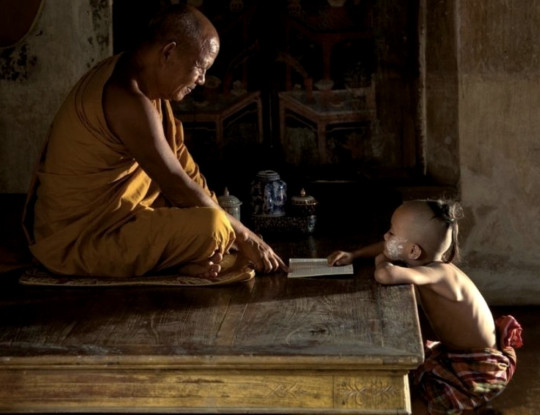
二十三夜堂からのメッセージ Q&A: その2 [その1]
次の質問は、天台宗についてもっと知りたい、日本国外で対面で学ぶ方法を知りたいというものでした:
伝来から1400年余りの年月を経て、日本の歴史文化のなかで、宗派の開祖たちから生まれたのが「日本の仏教。 現在、大きな宗派として存在しているのは、天台宗を含め約13宗派。その中で禅宗は、曹洞宗、臨済宗と黄檗宗の3宗。
中でも代表的なのは、天台宗の開祖の最澄、総本山は比叡山延暦寺、日本に密教をもたらした、真言宗の開祖の空海、総本山は高野山金剛峯寺、そして、坐禅修行のマニュアルとも言われている哲学書「正法眼蔵 (しょうぼうげんぞう)」の著者でマインドフルネスの元祖、曹洞宗の開祖の道元、大本山は永平寺など、が挙げられる。
仏教とは「ブッダの教え」という意味である。当初、全ては口頭で伝えられてお��文書·経典ができたのはブッダ没後のことだ。今日残っている仏教経典はすべて、ブッダの弟子たちの記憶によって記述されたもの。その間訳者の見解などを通して様々な変形を繰り返し、各国の代表的な教祖が宗派を立ち上げ分かれていった。天台宗はその一つで、最澄が立ち上げた宗派である。因みに私の信頼できる先生は曹洞宗の禅僧だが、彼は宗派に囚われるべきではないと言っている。というのも曹洞宗の開祖である道元禅師が「ブッダの教えは一つであり、宗派に執われるな」と教えていたからだ。
国外で対面学習や仏教思想を学びたいとご希望の方々は、ローカル��仏教寺院、または禅センターを訪ねてみると良いと思います。お決まりのキーワードを叩けば、すぐに見つかります。但し、全てが良い先生とは限りません。自分に合った先生やセンターを根気よく探すことをお勧めします。海外の方々は、日本の仏教学者、鈴木大拙氏の本が比較的手に入りやすいと思います。彼は英語で禅に関する著作を発表し、日本の禅文化を世界に紹介し、また中国語、韓国語、日本語、ベトナム語、サンスクリット語などの多作な翻訳者でした。
実際、私たちが学んでいる「禅」の教えは、これが絶対の真理だという聖典があるわけでも、これが絶対の真理だという教祖がいるわけでもありません。
宗派や文化で師を決めるのではなく、ご自分が共感できる門を叩くのが最良かと思います。もっと言えば、その人はお寺にのみいらっしゃるとも限りません。
101 notes
·
View notes
Text
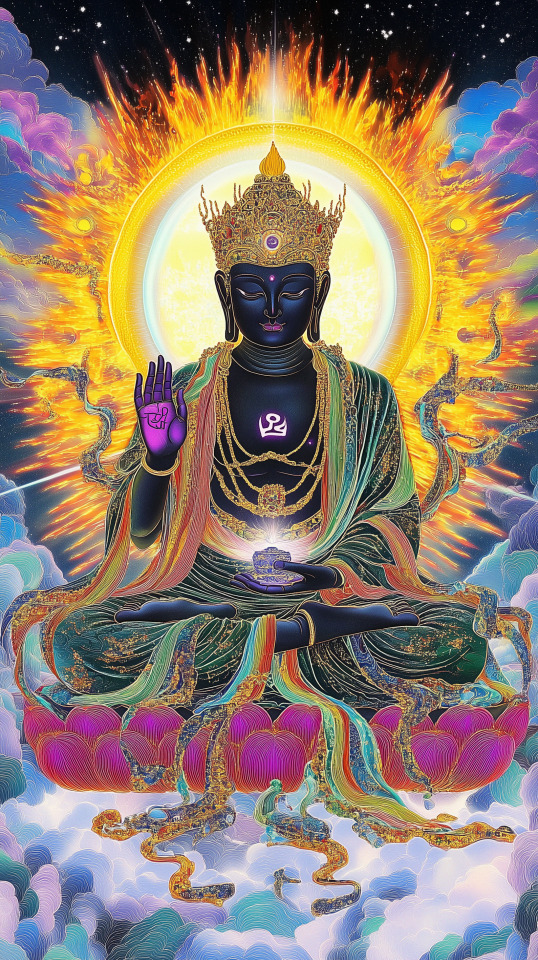
Maha Vairocana, Cosmic Sun Buddha Talon Abraxas
Vairocana is one of the Five Dhyani Buddhas created by Adhi Buddha. In Sanskrit, the name vairocana means "luminous" or "embodiment of light". In Chinese, Japanese, Tibetan, and Vietnamese Buddhism; Vairocana is called as Dari Rulai / Piluzhena Fo, Dainichi Nyorai, Nampar nangdze / Namnang, and Dai Nhat Nhu Lai respectively. In the above mentioned Buddhism, the Buddha is seen as the embodiment of Buddhist concept of Emptiness. While in Mahayana and Vajrayana Buddhism, Vairocana is considered as a Primordial Buddha and is located at the center. He is also referred to as the "great illuminating one," “the Life force that illuminates the universe," and importantly, "all-encompassing Buddha". Therefore, Vairocana is mentioned in different sutras.
In Brahma Net Sutra, it is written that Vairocana Buddha is seated on a top of a lotus pedestal and surrounding of that lotus there are thousands of flowers. These flowers are the Sakyamuni Buddhas, which supports a hundred million worlds. It is also mentioned that Sakyamuni Buddha is born in each world. They all attain Buddhahood at the same time under Bodhi tree. All these Sakyamuni Buddhas have Vairocana as their original body.
In Flower Garland Sutra, also called Avatamsaka, Vairocana is presented as the ground of being and the matrix from which all phenomena emerges. He is regarded as the Dharma Body of the historical Buddha (Siddhartha Gautama).
In Samantabhadra Meditation Sutra, also called as the "Sutra of Meditation on the Bodhisattva Universal Virtue", Vairocana is mentioned as a Buddha who has similar characteristics as that of Sakyamuni Buddha. And he roams around a place called "Always Tranquil Light".
Lotus Sutra, also called Saddharma Pundarika Sutra, is composed in the first century B.E.C. In this sutra, it is believed that Buddhas are said not to die even though their physical bodies degenerate. It is also mentioned that Buddha has explained that he has always lead the beings to their salvation and will always continue to do so. Therefore he is considered as the most sublime or truest reality in the universe.
In Mahavairocana Sutra, Vairocana is depicted as the universal Buddha from whom all other Buddha are originated. He is also represented as the source of enlightenment who helps others to be free from causes and conditions. It is also mentioned that Vairocana taught about the Dharma to Vajrasattva but it was incomprehensible to learn for them. That's why Vairocana provided esoteric techniques and rituals to help Vajrasattva to conceptualize the Dharma beyond verbal form. Therefore, Vairocana is also referred as a teacher, without whom there would have been no Buddhism, and also there would not have the path to enlightenment.
Even though Vairocana is mentioned in various Sutras, the doctrine of Vairocana Buddha is largely based on the teachings of the Mahavairocana Sutra. This Sutra is thought to be the earliest comprehensive manual of Buddhist tantra. It is believed that this Sutra is composed in the 7th Century.
Iconography
Vairocana Buddha is often depicted as seated in the lotus pedal which is supported by a pair of two great lions. Symbolically, it is represented that when the lions roar, all other remains silent and listens to him. Likewise, when one is spreading Buddha's teachings almost all others remains silent and listens to the Buddha's valuable teachings. When Vairocana Buddha is depicted as meditating, it is believed that the image of Vairocana helps to transform the delusion of ignorance into the wisdom preached by the Dharma. Similarly, when Gautama Buddha turned the wheel of Dharma, it illuminated the hearts of people which was darkened by ignorance.
When Vairocana Buddha is depicted in Buddha statues, he is also shown in Dharma chakra mudra. This mudra is formed when the thumb and index finger of both hands touch at their tips to form a circle. The left hand faces inward which covers the right hand which is facing outward and the hands are held against the chest. The remaining fingers of both hands remain extended.
Since Vairocana is believed to be the aggregate of all the Dhyani Buddhas. Therefore, He has the complexion of pure white since white produced when all the colors merge together. His symbol is the dharma wheel. When all Five Dhyani Buddhas are depicted together in a mandala, Vairocana is placed in the center. He is often shown larger than other Buddhas around him. He is Lord of Akanistha Ghanavyuha Pure land which existed in the center. His consort is White Tara and his Bija starts with Om. In Vajrayana Buddhism, it is believed that Vairocana Buddha helps to overcome ignorance and delusion when a person chants his mantra.
Vairocana Sadhana - Diamond Realm:
29 notes
·
View notes
Text
𓍼 ྀ ۫ ۪ ׄ ͡꒱ . . the sun shines for all . . ᭝ ᨳଓ ՟




ᛝ ∿ ⁺ i go by via in general and i have gotten into loa for two years, started my blog only for a few months though. i usually just post whatever i want, to be honest, but my posts are a mixture of non-dualism and law of assumptions. most of my beliefs are from the hindu and buddhist scripts + neville and other philosophers.
ᛝ i am eighteen and is vietnamese chinese. i love writing, reading, and listening to music. my top favourite artists is ethel cain, sufjan stevens, sade, the japanese house, and the 1975.
ᛝ this is a digital guide book. im simply here to spread my knowledge.
⨳ ˚ 𖨂 disclaimers . . .
before sending a dm, please make sure you read the sources i have linked in my intro. i will not reply if you trauma dump/rant without asking.
i will also NOT be replying to anti-loas and anti-shifters asks, so save your breath. this is not safe space for limited beliefs.
do not ask me to enter the void for you.
𓉸ྀི ˚ 𓍼 helpful sources ˚ 𓍼ྀ ₊
͡꒱ the void state explained through buddhism and hinduism
͡꒱ you are god
͡꒱ a study conducted on people's awareness in their sleep
͡꒱ the infatuated ego
͡꒱ words of comforts
͡꒱ use your imagination
͡꒱ barbados is a mindset
͡꒱ the potter and the clay
𓉸ྀི ˚ 𓍼 helpful sources from others ˚ 𓍼ྀ ₊
͡꒱ a youtube playlist of bill donahue's lectures
͡꒱ alia's post on the self
͡꒱ lola on doing nothing

24 notes
·
View notes
Text
Cultural Practices: Banyan-Grove Tree Pt. 1

The Foggy Swamp’s banyan-grove tree is hybrid of a banyan tree and a mangrove tree; the banyan aspect stems from the aerial roots descending from its branches, while the mangrove aspect stems from its ability to thrive in a wetland environment. Both trees are also native to Vietnam, which was a huge inspiration for the Foggy Swamp and its surrounding areas.
@tuktukpodfics did an amazing analysis of the banyan-tree’s ecological symbolism, so I won’t go any more in-depth into the botany of these plants.
The banyan tree is significant in Buddhism, Hinduism, and Vietnamese culture. In Buddhism, Siddhartha Gautama (the Buddha) achieved enlightenment after meditating under a species of banyan tree; this is even referenced in the episode by Huu, who reached enlightenment the exact same way. Fun fact: The banyan species that the Buddha meditates under is colloquially known as a “bodhi tree”, due to its cultural significance.
In Hindu culture, the tree is believed to attract ghosts and is often planted near crematoriums. This is because the tree simultaneously symbolizes both immortality and death. The tree itself is perceived as immortal due to its many deeply ingrained and expansive roots. At the same time, where ever the tree grows, no other plant life can live. In other words, Immortality + Death = Ghosts.
These cultural undertones are why the Foggy Swamp inspires both great wisdom and fear from those who visit it. Similarly, this is also why banyan trees are so prominent in the spirit world. They’re basically the physical embodiment of the spirit world.
In Part 2, I’ll discuss the banyan tree’s significance in Vietnamese culture.
Like what I’m doing? Tips always appreciated, never expected. ^_^
https://ko-fi.com/atlaculture
400 notes
·
View notes
Text

Our Beloved Kwan Yin
The Great Compassion Bodhisattva
(Avalokitesvara Bodhisattva)
Long ago, according to legend, Kuan Yin earned the right to enter Nirvana after her death. But when she stood before the gates of paradise, she heard the anguished voices of those left on earth and, turning away from bliss, vowed to remain in the world, gently leading others until all living things reached enlightenment. Kuan Yin, a bodhisattva, became the goddess of compassion, or 'she who hears the cries of the world,' and her message spread beyond the Chinese Buddhist community. Today she is known by many names in many countries. Because of her popularity, she is depicted in hundreds of ways. Most often shown as a slim and graceful barefoot woman dressed in flowing white robes, she is the embodiment of empathy, unconditional love, and perfect compassion. Sometimes she transforms herself - into a child, a man, or even a king - to better guide and teach the path to Nirvana.
Kuan Yin's goal is to liberate all beings from suffering, no matter who or what they are, and thus building a relationship with her involves little. There is no required ritual or dogma. Rather, her devotees strive to emulate her compassion and caring in their own lives by attempting to adhere to the standards of the goddess and by serving others. Kuan Yin's unselfish devotion to all living beings is key. She is free from pride and vengefulness, and passes no judgment. She is reluctant grants great comfort to the lost, the sick, the senile, the troubled, and the unfortunate. In the tales surrounding Kuan Yin, the dejected need only cry out to her for help to be freed from fear and danger.
Embracing the way of Kuan Yin is as easy as cultivating her virtues, which are said to exist deep within all beings, in your own life. You may want to meditate on her sacrifice and ask yourself what selfless actions you could take to better the world. She provides us with an example of how to better relate to the world and each other, asking us simply to treat all living things as we ourselves would be treated.
Kuan Yin is also spelled Guan Yin, is the bodhisattva of compassion venerated by East Asian Buddhists. Commonly known as the Goddess of Mercy, Kuan Yin is also revered by Chinese Taoists as an Immortal. The name Kuan Yin is short for Kuan Shih Yin (Guan Shi Yin) which means "Observing the Sounds of the World".
In Japanese, Kuan Yin is called Kannon or more formally Kanzeon; the spelling Kwannon, resulting from an obsolete system of Romanization, is sometimes seen. In Korean, she is called Kwan-um or Kwan-se-um. In Vietnamese, she is called Quan Âm or Quan Thế Âm Bồ Tát.
Praise To Kuan Yin Bodhisattva
Kuan Yin Bodhisattva's compassion for all beings is so vast and inconceivable, our gratitude cannot comprehend nor fully express the magnitude of her blessings. Her body and garments of brilliant, translucent White Light. Her adornments, a white vase of Compassionate Water in her left hand, The Sacred Willow Branch in her right hand.
Enlightened through infinite acts of compassion countless lifetimes ago. Her feet rest upon a fragrant red lotus flower above a vast ocean. Her brows curved and radiant like the crescent of an autumn moon. With the sweet dew drops she sprinkles from her vase, She relieves the suffering of beings everywhere and always, for countless autumns.
Prayers for help arise from thousands of hearts, and thousands of prayers are answered by her vow of eternal compassion: Beings in Samsara, who sail the ocean of suffering, She will guide and deliver safely to the ultimate shore of enlightenment.
Avalokitesvara (known as Chenrezig in Tibetan) is an important deity in Tibetan Buddhism. In particular, the Dalai Lama is held to be a manifestation of Avalokitesvara.
Other manifestations popular in Tibet include Sahasra-bhuja (a form with a thousand arms) and Ekādaśamukha (a form with eleven faces).
In Tibetan Buddhism, White Tara acts as the consort and energizer of Avalokitesvara. According to popular belief, Tara came into existence from a tear of Avalokitesvara. When the tear fell to the ground, it created a lake, and a lotus opening in the lake revealed Tara. Another version of this tale tells that Tara emerged from the heart of Avalokitesvara. In both, it is Avalokitesvara's outpouring of compassion which manifests Tara as a being.
Tibetan Buddhism relates Avalokitesvara to the six-syllable mantra Om Mani Padme Hum, also spelled Om Mani Peme Hung and Om Mani Padme Hon. It is for this reason that Avalokitesvara is also called Shadakshari, Lord of the Six Syllables.
In the Tibetan tradition, Avalokiteshvara is seen as arising from two sources. One is the relative source, where in a previous kalpa (era), a devoted, compassionate Buddhist monk became a Bodhisattva, thus giving the present kalpa its form of Avalokitesvara. That is not in conflict, however, with the ultimate source view, which is Avalokiteshvara as the universal manifestation of compassion. In brief, it may be said that the Bodhisattva is the anthropomorphised vehicle for the actual deity, serving to bring about a better understanding of Avalokitesvara to humankind.
***
20 notes
·
View notes
Text

Vietnamese monk Thích Quảng Đức setting himself on fire to protest the oppression of Buddhism in 1963, Saigon, modern-day Ho Chi Minh City, Vietnam
French vintage postcard
#vietnamese#monk#modern-day#briefkaart#photography#vintage#quảng#modern#tarjeta#postkaart#french#postal#vietnam#1963#saigon#photo#thích quảng#protest#postcard#historic#carte postale#fire#city#setting#thch#minh#ephemera#sepia#ho chi minh city#ansichtskarte
19 notes
·
View notes
Text

Art by Not A Starchild
LOVE MEN AND WOMEN, NEITHER WOMAN NOR MAN
(Tiếng Việt ở dưới)
In folk culture, it was believed that true men had 7 spirits and true women had 9. This concept also appeared in the Mother Goddess Worship (or Đạo Mẫu), the indigenous religion of Kinh ethnic Vietnamese. During Đạo Mẫu’s mediumship ritual, mediums would often cross-dress with colorful costumes: men wore feminine dresses, and women wore masculine robes. Based on the belief system, these mediums always had spiritual roots with one deity, therefore they would perform mediumship with that divinity’s clothing; oftentimes, male mediums had roots with goddesses, and female mediums had roots with gods. According to an old medium Lưu Ngọc Đức, a medium with elements of both genders would be better in conveying the characteristics of the divine: thus explaining the existence of 8-spirit people, who existed in-between the gender binary.
Within this belief, men with 8 spirits were given one more soul compared to the norm, and women with 8 spirits were omitted one soul from the norm; thus, they were viewed as feminine men and masculine women. Most 8-spirit people who practiced Đạo Mẫu were homosexual, or simply loved people of the same sex or gender. Once becoming mediums, these people were highly respected within the community, seen as closer to the gods and could perform better mediumship. This idea continued to this day.
Mediums weren’t the only ones who transcended gender binary; gods were as well. Deities within the Mother Goddess Worship could transform into men or women at will (this originated from Buddhism, whose pantheon was also filled with gender bending beings). In modern terminology, they were genderfluid. Since the holies could be either men or women, a person with both masculine and feminine characteristics would be considered more suitable for the mediumship ritual.
Excerpt from the Council of Four Palaces prayer: “The forest lush of reverent mountains and rivers, the sea dense and outstanding of streams and hills. The heroic spirit is bright with immeasurable transformations, either from swimming in the jaded void, or arriving at the Tower of Immortals, or to go and back from chaos or order at heaven and earth, or march toward the Isle of Immortals unhindered from the world. Whether they be in the form of man or woman, whether they commit disaster or evil, one must pray to them for successful passage, for they will respond to immediate requests.”
Excerpt from the Mountains Village prayer: “Only wish: To be holy and godly, to be man and woman. Bright light descends on the fated altar to prove virtuous merits.”
Excerpt from the Holy Council prayer request: “Mahāsthāmaprāpta bodhisattva, with golden lotus and golden flag, with golden visage and golden body, as holy and godly, as man and woman, whose beautified disciples repaired Mount Pǔtuó, who is morally supreme, who will become Buddha.”
==================
ÁI NAM ÁI NỮ, VI NỮ VI NAM
Trong dân gian vẫn truyền lại rằng đàn ông có 7 vía, đàn bà có 9 vía. Quan niệm này cũng xuất hiện trong Đạo Mẫu 道母, tín ngưỡng bản địa của dân tộc Kinh. Trong nghi thức lên đồng của Đạo Mẫu, các thanh đồng thường sẽ đảo trang với các y phục sặc sỡ màu sắc: trai mặc đồ nữ, gái mặc đồ nam. Theo tín ngưỡng, các thanh đồng đều có căn với một vị thiêng, nên sẽ lên đồng với trang phục của vị ấy; nhiều lúc, các cậu đồng có căn nữ thần, và các cô đồng có căn nam thần. Theo cụ đồng Lưu Ngọc Đức 劉玉德, để việc lên đồng tốt hơn, một thanh đồng nên có yếu tố của nam lẫn nữ, như thế mới hoàn toàn truyền tải được tính cách của các đấng linh: vì thế mà có người 8 vía, được xem là tồn tại giữa nam và nữ.
Dường như là quy luật thêm trừ, đàn ông 8 vía là những người được tạo hoá ban tặng thêm cho một vía nữa so với chuẩn mực, còn đàn bà 8 vía thì bị lược đi một vía; vì vậy, có thể nói rằng họ là những đàn ông nữ tính và đàn bà nam tính, khi số vía của họ đứng giữa số vía của nam và nữ. Đa phần các người 8 vía trong Đạo Mẫu đều là đồng tính, hoặc đơn giản là yêu người cùng giới. Những vị này khi trở thành thanh đồng đều được người trong đạo hết sức tôn trọng, được xem là gần với các thánh thần hơn, vì thế mà lên đồng và hầu đồng tốt hơn.
Không chỉ các thanh đồng có thể vượt khỏi hệ nhị phân giới, mà thậm chí các vị thánh thần cũng thế. Thần linh trong Đạo Mẫu đều vi nam vi nữ (có gốc từ đạo Phật, một tôn giáo với rất nhiều thánh linh không tuân theo luật giới tính của con người), tức có thể hoá nữ hoặc nam. Theo thuật ngữ hiện đại, họ là linh hoạt giới. Vì các vị thánh đều vi nữ vi nam, nên một người với tính chất của nam lẫn nữ sẽ được xem là phù hợp với nghi thức hầu bóng hơn.
Trích khoa cúng Tứ phủ hội đồng 科供四府會同: “Lâm trung uất uất thúc nhiên sơn thuỷ chi dung, hải thượng sâm sâm trác nhĩ yên hà chi cảnh, anh linh bất muội biến hoá nan lường, hoặc du Bích Lạc chi trung, hoặc nghệ Bồng Đài chi nội, hoặc hồi lãng uyển tự thăng giáng ư càn khôn, hoặc vãng Bồng Lai nhậm tung hoành ư thế giới, vi nam vi nữ, tác nghiệt tác yêu, đảo dĩ toại thông, cầu chi tất ứng.” (林中鬱鬱蹴然山水之容,海上森森卓爾煙霞之景,英靈不昧變化難量,或游碧落之中,或詣蓬臺之内,或回浪踠序升降於乾坤,或往蓬萊任縱橫於世界,為男為女,作孽作妖,禱以遂通,求之必應。)
Trích khoa cúng Sơn Trang 科供山莊: “Duy nguyện: Nãi thánh nãi thần, vi nam vi nữ. Quang giáng đàn duyên chứng minh công đức.” (惟願:乃聖乃神,為男為女。光降壇緣證明功德。)
Trích thỉnh thánh hội đồng khoa 請聖會同科: “Quan âm thế chí, kim liên kim xí, kim tướng kim thân, vi thánh vi thần, vi nam vi nữ, trang hoàng đệ tử, tu phổ đà sơn, đạo đức chí tôn, hoá vi thành Phật.” (觀音勢至,金蓮金幟,金相金身,為聖為神,為男為女,粧煌弟子,修普陀山,道德至尊,化為成佛。)
__________ Tham khảo: hoangtrongmuon.blogtiengviet.net/2008/09/27/a_ann_aang_8_vasa researchgate.net/publication/335060264_Social_effects_of_Dao_Mau youtube.com/watch?v=nk9wSZsHBwA youtube.com/watch?app=desktop&v=c2N_aoRZxqs&feature=youtu.be&ab_channel=HOAILUONGNGUYEN
__________ *Ái nam ái nữ: một từ vựng lỗi thời để chỉ song tính luyến ái hoặc liên giới tính, nhưng vốn cũng chỉ mọi người trong cộng đồng LGBT+ như đồng tính luyến ái và người chuyển giới
*Song tính luyến ái (bisexuality): mối quan hệ hay chỉ sự hấp dẫn tình cảm hoặc tình dục của một người với hai giới tính, nam và nữ, hoặc là nhiều hơn một phái tính hay giới tính
*Liên giới tính (intersex): những người khi sinh ra có cấu trúc sinh dục không giống với những suy nghĩ thông thường về nam và nữ, khi các đặc điểm giới tính sinh học của họ không điển hình là nam hay nữ
*Người chuyển giới (transgender): một người nhận thức bản thân thuộc về một giới tính mà giới tính đó không đồng nhất với đặc điểm giới tính của cơ thể khi sinh ra
*Đồng tính luyến ái (homosexuality): những người có sự hấp dẫn tình yêu, tình dục với những người cùng giới tính với nhau trong hoàn cảnh nào đó hoặc một cách lâu dài
*Hệ nhị phân giới (gender binary): sự phân loại giới thành hai thái cực đối lập nhau, hoặc là nam, hoặc là nữ, thường theo hệ thống xã hội hoặc theo từng vùng văn hoá
*Linh hoạt giới (genderfluid): những người có giới linh hoạt và thay đổi thay vì chỉ gắn với một giới cả đời; tuỳ từng người có chu kì thay đổi giới, có người sẽ có giới của mình luân chuyển theo ngày, tháng, hay thậm cả năm mới thay đổi
117 notes
·
View notes
Text
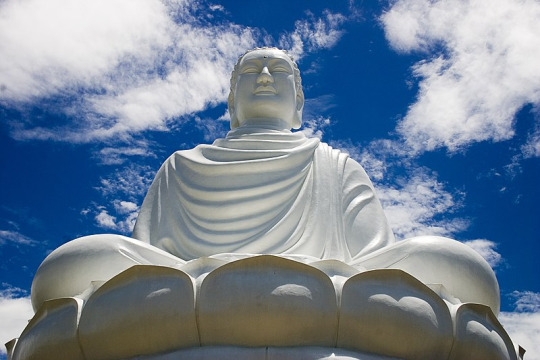
Religion in Vietnam
Despite Vietnam being on atheist state officially, religion is an integral part of Vietnamese culture and everyday life. While Buddhism, Catholicism and Protestantism find followers in the country, the dominant religion is the Vietnamese folk religion. This religion combines elements of Confucianism, Taoism and Buddhism along with indigenous practices.
Vietnamese Folk Religion
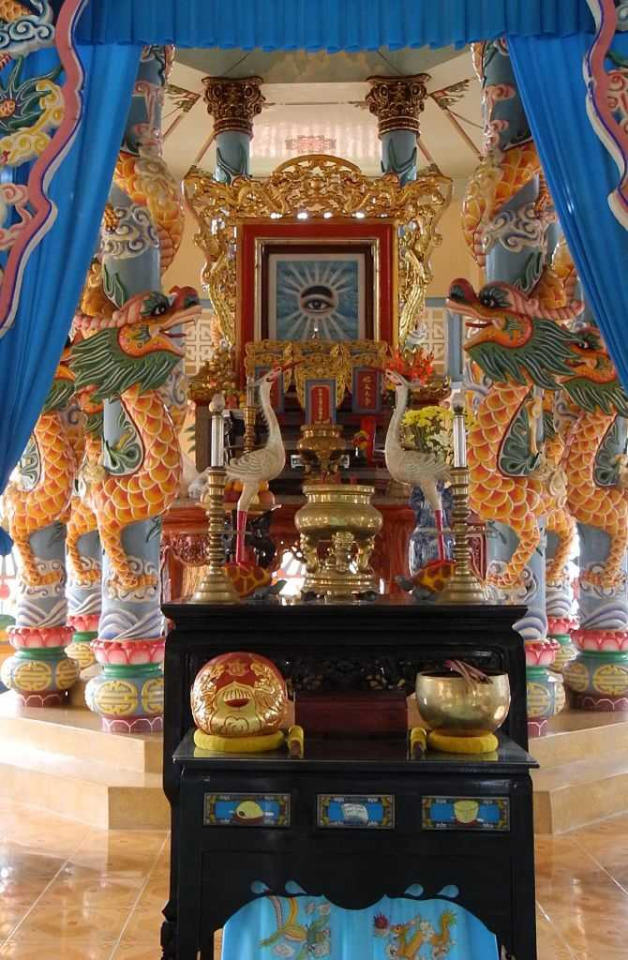
Cao Daism, a monotheistic Vietnamese folk religion fusing aspects of Confucianism, Taosim, and Buddhism
A major component of Vietnamese folk religion is the Than (spirit or deity) which may be nature gods, community deities or ancestral gods of a particular family. Ancestral veneration is especially prevalent, and narratives of heroic acts and cosmic forces abound in local mythology. The temples, known as Mieu are usually located away from the city's bustle in more secluded areas. Mother Goddesses also form an important part of the theological aspect of Vietnamese culture; The Lady of the Realm and the Trung sisters have multiple shrines across the country.
Buddhism in Vietnam
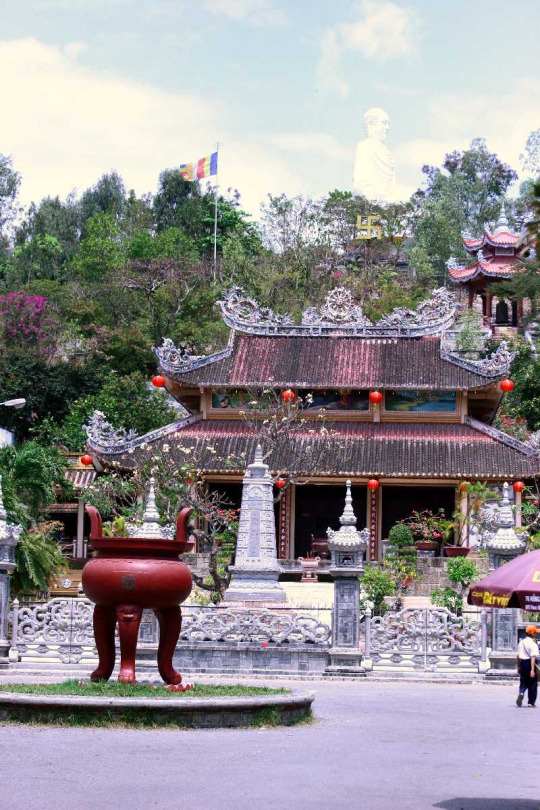
The Long Son Pagoda in Nha Trang, a Buddhist Temple with a large white marble Buddha statue seen behind it
Buddhism arrived in Vietnam through India and China as early as the second century AD. Vietnamese Buddhism is significantly different from the way it is practised elsewhere, as is evident by the absence of sanghas, hierarchy and other institutional structures that usually exist. Mahayana Buddhism is the dominant school of Buddhism here, coupled with elements of Taoism and Chinese beliefs. Practitioners focus less on spirituality and more on devotional rituals such as chanting sutras and dharanis to obtain the blessing of Bodhisattvas.
Christianity
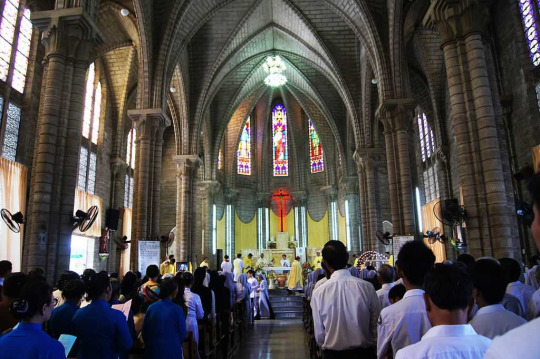
Mass in progress at the Christ Church, Nha Trang
The most widespread church in Vietnam is the Roman Catholic church, which arrived with the Portuguese missionaries and strengthened its foothold with the French colonialists. The national language script of Vietnam used in present times, written in the Latin alphabet with diacritics, also came into use with the help of these missionaries. Protestantism also gained following over the last century, and now has over 50,000 practitioners.
19 notes
·
View notes